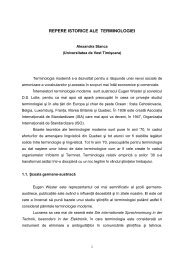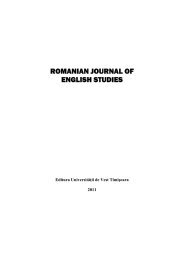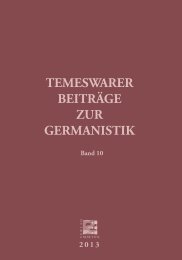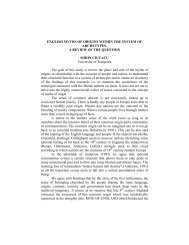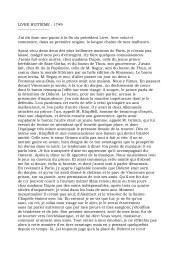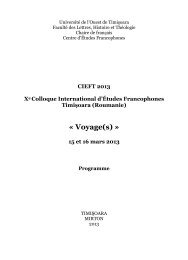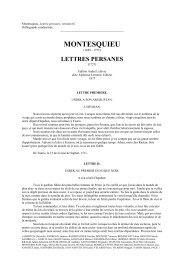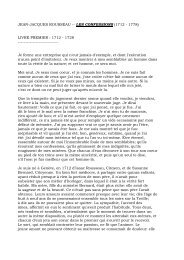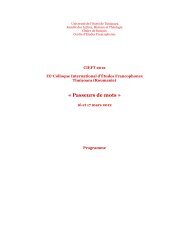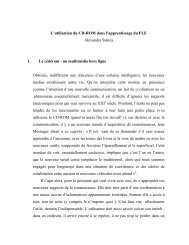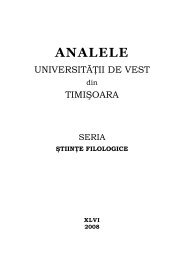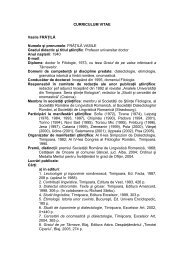TRANSLATION AND MEANING: A CULTURAL- COGNITIVE ...
TRANSLATION AND MEANING: A CULTURAL- COGNITIVE ...
TRANSLATION AND MEANING: A CULTURAL- COGNITIVE ...
You also want an ePaper? Increase the reach of your titles
YUMPU automatically turns print PDFs into web optimized ePapers that Google loves.
fluent translation; 5) With the most proficient students, there was very little<br />
difference between instant and elaborated translations.<br />
9. Conclusions. Any translation remains “an impossible venture”<br />
(Correia, 2003:38), since there is no one-to-one relationship between<br />
languages, and the cultures to which they belong. The mental and emotional<br />
associations are almost completely different. “However hard we marshal our<br />
resources and draw on our experience, the end result will never be the same<br />
as the text with which we started” (Correia, 2003:38). Therefore, it is a<br />
utopia to consider the translating process as the pursuit of textual identity,<br />
since changing the language of the text entails changing other elements.<br />
This principle will break the cultural convention, which, “in spite of all<br />
evidence, expects the ST and the TT to coincide” (Correia, 2003:38).<br />
To conclude, besides the shifts from the ST in terms of structure and<br />
meaning, the shift is also obvious in Translation Studies from the<br />
translator’s subjectivity to the more objective constraints of the text.<br />
Stress is laid on the new role of the translator as communicator, on<br />
his/ her task of discriminating between the pragmatic dimensions of the<br />
context, of being aware of its semiotic function, and of the focus type of the<br />
text, as well as of designing the new text structure in translation having a<br />
good command of the discourse texture in the TL.<br />
Many questions concerning the translator as mediator, and the<br />
difficulties of translating between remote cultures are still open, possibly<br />
because cultures are difficult to define even in an age of ‘international’<br />
culture, as their interpenetration is continual and dynamic, and, in other<br />
words, because different cultures come together under the global<br />
communication umbrella.<br />
References<br />
Baker, M. 1995. ‘Corpora in Translation Studies: An Overview and Some Suggestions for<br />
Future Research’ in Target 7 (2).<br />
Baker, M. 2000. ‘Towards a Methodology for Investigating the Style of a Literary<br />
Translator’ in Target 12 (2).<br />
Biber, D., Conrad, S., Reppen, R. 1998. Corpus Linguistics: Investigating Language<br />
Structure and Use. Cambridge: Cambridge University Press.<br />
Bulgăr, Gh. 2003. Dicţionar de sinonime. Bucureşti: Editura Lucman.<br />
Carter, R. 1987. Vocabulary. Applied Linguistic Perspectives. London: Allen and Unwin.<br />
Chesterman, A. 1997. Memes of Translation. Amsterdam: John Benjamins.<br />
Chuquet, H., Paillard, M. 1987. Approche linguistique des problèmes de traduction. Gap :<br />
Ophrys.<br />
Correia, R. 2003. ‘Translation of EU Legal Texts’ in Crossing Barriers and Bridging<br />
Cultures. A. Tosi (ed). Clevendon-Buffalo-Torronto-Sydney: Multilingual Matters<br />
Ltd.



